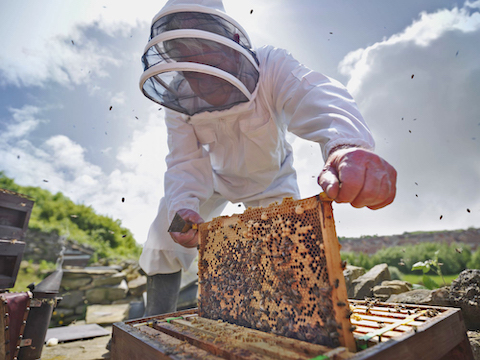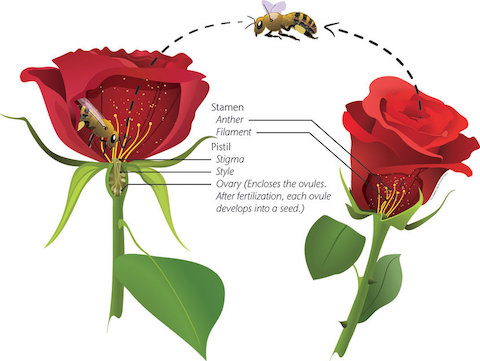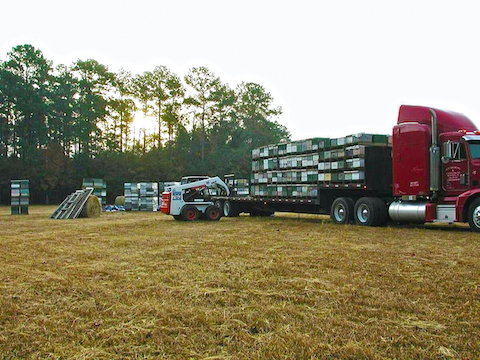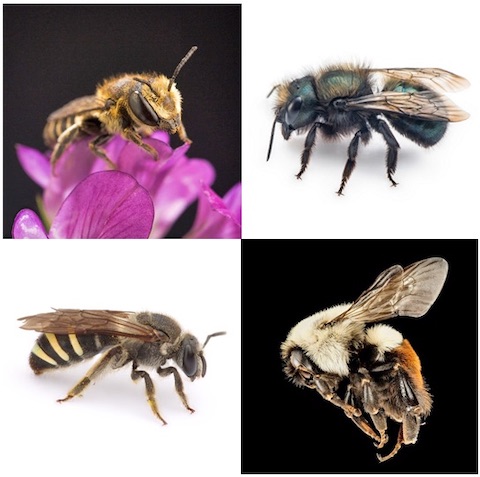
Bees make over $300 million worth of honey, beeswax, propolis, and other products each year in the U.S., which we eat and use in medicines, cosmetics, even varnishes.
But the real big business of bees is the billions of dollars keepers earn pollinating crops.
Bee colonies are treated, and valued, like livestock. The keepers move the hives to the best positions for most effective pollination on a strict schedule, following the flowering of crops across the country.
They start in February, in California, where almond growers need 2 million hives to pollinate their trees. A typical farmer could pay several hundred thousand dollars for this service.
In March, keepers transport their colonies to pollinate plums, cherries, and apples in the Pacific Northwest and Midwest.
In early April, the hives go to Maine to pollinate blueberries. And in late April, down to Florida to work the citrus crop.
Finally, in May, bee colonies retire to the Dakotas, where they’ll spend the quiet rest of the year on fields of clover and sunflower.
Here, the bees make most of their honey. North Dakota produces twice as much honey as any other state.
Honeybees and other insects are the only pollinators for all these and many other crops—about a third of our agricultural harvest—putting food on the table around the world.
But bees have come under threat recently from pesticides, pests, and disease. We’ll look at these dangers and possible solutions in our final episode on honeybees.
Background
Synopsis: Honeybees (Apis mellifera) are big business, and their honey is just a by-product of the main business of apiculture: commercial pollination services for food crops. Beekeepers begin their travelling lifestyle in January and keep moving around the country until early summer. Some alternative pollinators are available for specific crops, but domesticated honeybees dominate, pollinating about one-third of our food crops. In addition to the health benefits of delicious honey, we can thank the honeybee for the abundance and variety of vegetables, fruits, and nuts in our markets.
- The United States produces more than 160 million pounds of honey annually, a yield that has been valued at over $300 million in recent years.
- In previous EarthDate episodes, we discussed the amazing life cycle of honeybees and some of the health benefits of honey and other bee products.
- Honey is used for food, medical dressings, skin creams, and lotions. Beeswax and propolis are used for products like cosmetics, toothpaste, mouthwash, and as a varnish for musical instruments.
- But these products are just a secondary by-product to the more important agricultural industry of honeybee pollination, which puts food on our plates and is worth many billions of dollars.
- Beekeepers have tended hives for centuries, not only for honey, but because they relied on bees for crop pollination.
- Just like the crops that were imported from Europe, honeybees were non-native to the New World. The first records of honeybee hives arriving in the New World show they were transported to Jamestown, Virginia, from England in 1622.
- Today, domesticated honeybees (Apis mellifera) pollinate about 35% of the food crops that Americans consume.

- More than a quarter of a million flowering plant species depend on pollinators to transfer pollen from male anthers to female stigma in order to reproduce, while other plants depend on physical processes like gravity, wind, or water to distribute pollen.
- Some flowers are self-pollinating and only require short-distance transport of their pollen to their own stigma, or to other blossoms on the same plant.
- Other plants require cross-pollination, meaning that the pollen of one plant must reach the stigma of a different plant of the same species. Usually this can only be done via pollinators.
- The timing of pollination is critical. Pollinators need to be available when crops are flowering, which is sometimes only a couple of weeks per year.
- The more flowers that are pollinated, the more of the food crop is produced, so having abundant bees pollinating plants increases crop yield.
- Of about 115 leading global crops, pollinators are necessary for about a third of them.
- Crop pollination is a major agricultural industry, and honeybee colonies are moved like livestock around the country. Hives are placed precisely where they are needed and at exactly the right time to provide optimal pollination for our favorite foods.
- The pollination season starts in California—the site of the largest managed annual pollination event in the world. More than 2 million hives are placed every season.
- California produces 80% of the world’s almonds, a crop that requires two hives (about 80,000 bees) per acre of trees for cross-pollination from tree to tree. This pollination must take place within a short 3-week period in February. A typical almond farmer may spend more than $300,000 a year for pollination services.
- Every year, almond growers attempt to grow their yield by adding 200,000 more hives for that short 3-week period.
- This huge population of bees for the California almond crop drives the annual migration of beekeepers who need to find other sources of nectar for their livestock through the remainder of the year.
- In March, the hives travel north and east from California to pollinate plums, cherries, and apples in the Pacific Northwest and the Midwest.
- Crops like watermelon, cherries, squash, and cucumber produce more food per acre in the presence of springtime pollination by commercial beehives.
- In early April, beehives travel to Maine to pollinate blueberries. By late April, they are needed down the coast in Florida to pollinate groves of citrus.
- Finally, in May, the honeybee colonies are relocated to the bountiful fields of clover, canola, and sunflowers in the Dakotas, where they can get some rest and relaxation.
- There they produce honey until the next pollinating cycle starts with almonds in February in California. As a result, North Dakota produces twice as much honey as any other state.
- The pollination season starts in California—the site of the largest managed annual pollination event in the world. More than 2 million hives are placed every season.

- Honeybees are not the only domesticated pollinating livestock—four other types of bees are also used in commercial pollination services for specific crops.
- Osmia lignaria, the blue orchard bee, pollinates tree fruits and nuts and may be available for pollination in cooler temperatures, before honeybees are ready to leave the hive.
- Bombus impatiens, the bumblebee, pollinates watermelons and some blueberries.
- Megachile rotundata, the alfalfa leafcutter bee, pollinates much of the alfalfa that is grown to produce seeds.
- Nomia melanderi, the ground nesting alkali bee, also pollinates alfalfa.
- Additional pollinators include thousands of species of wild bees as well as flies, spiders, small reptiles, bats, and birds.

- The abundant and diverse food crops we enjoy in the United States depend on commercial pollination, but honeybee colonies have recently come under multiple threats.
- Winter death tolls have recently increased from 15% to nearly 40% in 2019 due to stress, pests, diseases, and pesticide exposure.
- We’ll talk about threats to pollinators in a future episode of EarthDate.

